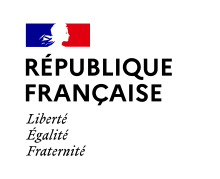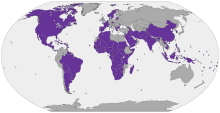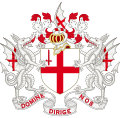Motto

Amotto(derived from theLatinmuttum,'mutter', by way ofItalianmotto,'word' or 'sentence')[1][2][3][4]is asentenceorphraseexpressing a belief or purpose,[1]or the general motivation or intention of an individual, family,social group,or organisation.[2][4]Mottos (or mottoes)[1]are usually found predominantly in written form (unlikeslogans,which may also be expressed orally), and may stem from long traditions of social foundations, or from significant events, such as a civil war or a revolution. One's motto may be in any language, butLatinhas been widely used, especially in theWestern world.
Language
[edit]Latinhas been very common for mottos in the Western World, but fornation states,their officialnational languageis generally chosen. Examples of using other historical languages in motto language include:
- CountyofSomersetin England:Sumorsǣte ealle(All the men of Somerset),Old English.[5][6]
- South Cambridgeshirein the EnglishFens:Niet Zonder Arbyt(Nothing without work),Dutch,originally the motto of Dutchman Cornelius Vermuyden, who drained The Fens in the 17th century.[7][8]
- South Africa:ǃke e: ǀxarra ǁke(Unity in diversity),ǀXam.
- ShireofShetland:Með lögum skal land byggja(By law shall the land be built up),Old Norse.[9]
Acantingmotto is one that containsword play.[10]For example, the motto of theEarl of OnslowisFestina lente(literally 'make haste slowly'), punningly interpreting 'on slow'.[11]Similarly, the motto of the Burgh ofTayport,Te oportet alte ferri(It is incumbent on you to carry yourself high), is a cant on 'Tayport at auld Tay Ferry', also alluding to the local lighthouse.[12]The motto of the U.S.Federal Bureau of Investigation,Fidelity, Bravery, Integrity,is abackronymof the letters F.B.I.
List of examples
[edit]
- United in diversity,the motto of theEuropean Union(EU)
- In God We Trust,the motto of theUnited States(US)
- Je MaintiendraiChâlons(French for "I will maintain Châlons" ), often abbreviated asJe maintiendrai(French for "I will maintain" ), the motto of theNetherlands
- Dieu et mon droit(French for "God and my right" ), is the motto of themonarch of the United Kingdom.It appears on a scroll beneath the shield of the version of thecoat of arms of the United Kingdom.
- Unus pro omnibus, omnes pro uno(Latin for "One for all, all for one" ), unofficial motto ofSwitzerland
- Post tenebras lux(Latin for "Light After Darkness" ), motto ofUniversity of Geneva
- United we stand, divided we fall[clarification needed]
Mottos in heraldry
[edit]| Part of aserieson |
| Heraldicachievement |
|---|
| External devices in addition to the centralcoat of arms |
|
|
Inheraldry,a motto is often foundbelowthe shield in abanderolein thecompartment.This placement stems from theMiddle Ages,in which the vast majority ofnoblespossessed acoat of armscomplete with a motto. In the case ofScottish heraldry,it is mandated to appearabovethe crest[13]and is called slogan (see:Slogan (heraldry)). The word 'slogan' is an Anglicisation of the Scottish Gaelicsluagh-ghairm(sluagh"army, host" +gairm"cry" ).[14]There are several notable slogans which are thought to originate from abattle or war cries.In heraldic literature, the terms 'rallying cry' respectively 'battle banner' are also common.[citation needed]Spanish coats of armsmay display a motto in thebordureof the shield.[15]
InEnglish heraldry,mottos are not granted with armorial bearings, and may be adopted and changed at will. In Scottish heraldry, mottos can only be changed by re-matriculation, with theLord Lyon King of Arms.[16]Although unusual in England, and perhaps outsideEnglish heraldic practice,there are some examples, such as inBelgium,of the particular appearance of the motto scroll and letters thereon beingblazoned;[17]a prominent example is theobverseof theGreat Seal of the United States(which is a coat of arms and follows heraldic conventions), the blazon for which specifies that the motto scroll is held in the beak of thebald eagleserving as the escutcheon'ssupporter.
-
Motto "Domine dirige nos" (Latinfor 'Lord, guide us')belowtheCoat of arms of the City of London
-
Abovethe crest is the slogan (see:Slogan (heraldry),most traditional inScottish heraldry) or thewar cry,Arms of Brady Brim-DeForest,Baron of Balvaird
Shipsandsubmarinesin theRoyal Navy(RN) each have abadgeand motto, as do units of theRoyal Air Force(RAF).[19][ISBN missing]
Mottos in literature
[edit]Inliterature,a motto is a sentence, phrase, poem, or word; prefixed to an essay, chapter, novel, or the like, suggestive of its subject matter. It is a short, suggestive expression of a guiding principle for the written material that follows.[4]
For example,Robert Louis Stevenson'sTravels with a Donkey in the Cévennesuses mottos at the start of each section.[20]
See also
[edit]- Epigram
- Epitaph
- Hendiatris
- List of Latin phrases
- List of mottos
- List of national mottos
- Mission statement
- Slogan
- Tagline
References
[edit]- ^abcmotto – Cambridge Dictionary.Cambridge,England:Cambridge University Press.2022.Retrieved1 November2022.
{{cite encyclopedia}}:|website=ignored (help) - ^ab"motto – Oxford Dictionaries".OxfordDictionaries.Oxford,England:Oxford University Press.Archived fromthe originalon 18 August 2016.Retrieved31 January2011.
- ^motto – Merriam-Webster.Merriam-Webster, Incorporated.2022.Retrieved1 November2022.
{{cite encyclopedia}}:|website=ignored (help) - ^abc"Webster's Revised Unabridged Dictionary (1913)".The ARTFL Project.The University of Chicago.Archived fromthe originalon 6 December 2013.Retrieved20 December2013.[failed verification]
- ^"The Danish Invasions".Somerset.gov.uk.Somerset County Councilarchives. Archived fromthe originalon 24 December 2013.Retrieved26 June2015.
- ^"Somerset - Coat of arms (crest) of Somerset".Heraldry-Wiki.Heraldry of the World. 19 March 2019.Retrieved1 November2022.
- ^"Civic Heraldry of England and Wales – East Anglia and Essex area".CivicHeraldry.co.uk.Archived fromthe originalon 28 August 2009.Retrieved8 November2009.
- ^"South Cambridgeshire".rsnonline.org.uk.Rural Services Network. Archived fromthe originalon 24 December 2013.Retrieved21 December2013.
- ^"Shetland Islands - Coat of arms (crest) of Shetland Islands".Heraldry-Wiki.Heraldry of the World. 13 October 2020.Archivedfrom the original on 26 May 2021.Retrieved1 November2022.
- ^The Manual of Heraldry: being a concise description of the several terms used, and containing a dictionary of every designation in the science. Illustrated by four hundred engravings on wood(5th ed.).London,England: Arthur Hall, Virtue & Co. 1800. p.132.OCLC1049649069.OL24349702M.Retrieved1 November2022.
- ^Mark Antony Lower (October 1860)."Onslow".Patronymica Britannica: A Dictionary of the Family Names of the United Kingdom.London,England: John Russell Smith.ISBN9780788404566.
- ^"Tayport - Coat of arms (crest) of Tayport".Heraldry-Wiki.Heraldry of the World. 13 October 2020.Retrieved1 November2022.
- ^von Volborth, Carl Alexander (March 1980).Heraldry of the World.Blandford Press. p.192.ISBN9780806999609.OL7944413M.
- ^"slogan".Merriam-Webster.2003. p. 1174.
- ^von Volborth, Carl Alexander (March 1980).Heraldry of the World.Blandford Press. p.211.ISBN9780806999609.OL7944413M.
- ^Innes-Smith, Robert (1990).An Outline of Heraldry in England and Scotland.Derby,England:Pilgrim Press.p.14, col 1.ISBN0-900594-82-9.OCLC1036776100.Retrieved1 November2022.
Mottos are not necessarily hereditary, and can be adopted and changed at will.
- ^"USS Winston S. Churchill (DDG-81)".The Institute of Heraldry.Retrieved21 February2024.
- ^"Juhana Herttuan patsas - Pori, Finland – Statues of historic figures".Waymarking.Groundspeak, Inc. 2022.Retrieved1 November2022.
- ^Cassells, Vic (2000).The capital ships: Their battles and their badges.Kangaroo Press. p. 190.
- ^Stevenson, Robert Louis(1907).Travels with a Donkey in the Cevennes.London,England:Chatto & Windus.



![Motto Deus protector noster (Latin for 'God is our protector') below the arms of Pori[18]](https://upload.wikimedia.org/wikipedia/commons/thumb/c/cb/Porin_vaakuna.svg/102px-Porin_vaakuna.svg.png)
